
 |
| Kyarakuta
( According to a survey of respondents ranging in age from seven to their sixties conducted in 2000 by the Bandai Character Laboratory, a toy research institute, the proportion of Japanese who owned character goods stood at 83.9 percent, and 87 percent responded that they had a favorite character. Just looking at men in their fifties and sixties, 54.7 percent owned some kind of character goods and 64 percent said they had a favorite character. Nowadays, media characters are popular among people of all ages, and there is nothing unusual in owning or using character goods. The character goods market in Japan is enormous, at over 2 trillion yen per year. Characters from Japanese manga like Pokemon ( |
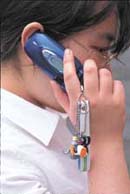 |
| Photo:Hongo Jin |
| “Characters” Everywhere | Photo:Hongo Jin | ||
| Rarely
will you go through a whole day without setting eyes on some sort of trademarked
character. They adorn ballpoint pens, notebooks, and other stationary
products, cosmetic accessories like hand-held mirrors and makeup pouches,
dangle from mobile phone straps and backpacks, and turn up on T-shirts,
and bicycle bumpers. "Characters" are effective attention-getters; they can soften the image of something that seems dull and uninteresting and make approachable things that seem complicated or daunting. Many banks now offer customers bankbooks, cash cards, and other business items sporting media character designs in addition to plainer, more conventional designs. Some characters are also originally created expressly for marketing businesses, events, and products. |
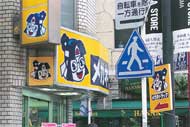 |
||
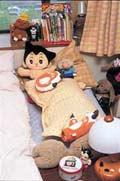 |
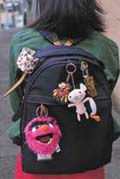 |
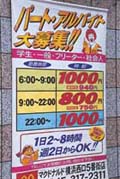 |
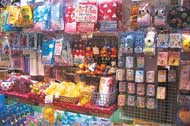 |
| Politicians as “Characters” | Photo:TJF |
The approval rate for the cabinet of Prime Minister Koizumi Jun'ichiro ( |
|
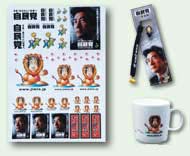
|
Their
style of speech, mannerisms, looks, and other characteristics unrelated
to their caliber as politicians became the object of popular fascination,
forming an extraordinary fad. For real-life politicians to be treated
along the same lines as trademarked characters and treated like popular
TV personalities was a provocative and unprecedented occurrence in Japan.
The Liberal Democratic Party itself, of which Prime Minister Koizumi is
a member, en-tered into the trademark character business by cre-ating
the character "Shishiro" ( |
| Mom and Dad Love Characters, Too | |||||
| In Japan today, anime and manga
are forms of entertainment anyone can enjoy, regardless of age. Men who
were ten years old in 1963 when the animated TV program Astro Boy
(Tetsuwan Atomu |
Original text : The Japan Forum Newsletter No. 25 "Japanese Culture Now" June 2002.
Send feedback to forum@tjf.or.jp